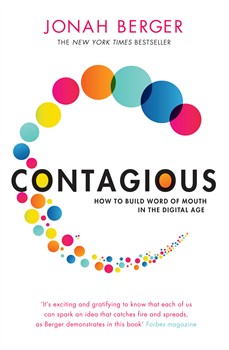Why does some content go viral – while other, possibly equally good content, languishes unnoticed?
For content marketers trying to get their brands known (and loved) on social media, understanding this process is the holy grail. Unfortunately, while it is usually easy to explain in hindsight why some material was wildly successful, it is quite hard to design it with virality guaranteed.
In his book Contagious: How to Build Word of Mouth in the Digital Age, Jonah Berger, associate professor of marketing at the Wharton School at the University of Pennsylvania, nevertheless tries to provide a framework. Ideas which get shared a lot, he claims, contain one or more of the following:
1. Social currency. The product / idea makes people feel that they have special insider knowledge and are ‘cool’.
2. Triggers. There is something in people’s everyday routine or environment that consistently reminds them of your product. (For example, KitKat is now associated with coffee breaks.)
3. Emotional resonance. When stories or ideas provoke high emotions, people are more inclined to share them.
4. Observability. When you can see that others are adopting / sharing the idea, you are more likely to as well.
5. Usefulness. When the product or information is practical or helpful.
6. Storytelling. People are more likely to remember, and to pass on, information that is embedded in a story, rather than dry facts.
How does all this apply to social media marketing? Here are 9 of my favourite lessons from the book. They are not necessarily the main points Berger makes, and do not correspond to all of the above points, but they are most practically useful!
1. Use emotion… Berger analysed the most shared articles in the New York Times and concluded that pieces that generated strong feelings were shared more often. If you want your product to be talked about, then, don’t focus on facts or on its features. You need to figure out what emotion it can bring out in clients.
Think your product is too boring for this? Berger brought the example of Google. Although the search engine has no obvious emotional hook, one video advertising campaign featured successive searches for a study programme in Paris, cafes near the Louvre, advice on impressing a French girl, Paris churches and finally tips on how to assemble a crib.
By showing how Google helped along a love story, it turned a utilitarian product into an emotional one.
To find the emotional core of your product, Berger recommends (based on an idea by Chip and Dan Heath) that you think about the ways in which people use it, and then ask yourself “why is this important” three times, until you reach a meaningful answer.
For example, people use Google to search – in order to find information quickly >> to get answers >> to connect with people, achieve their goals and fulfil their dreams.
2. …But not all emotions. Is it useful to connect any emotion to your product? No. Berger concluded that the emotions that provoked sharing where those that got people physically aroused, such as anger, excitement, awe, and amusement (humour). People get worked up by what they read – and decide to do something about it, by sharing.
Those emotions that had the opposite effect, making people relax, power down or stifle action decreased sharing. These included sadness and contentment.
Practical conclusion: Make people mad, not sad.
 3. Make your product scarce and exclusive. If something is not readily available, or if it is available only to those who meet certain criteria, it creates a feeling of high demand and desirability.
3. Make your product scarce and exclusive. If something is not readily available, or if it is available only to those who meet certain criteria, it creates a feeling of high demand and desirability.
Berger brings a couple of examples of companies that sold the exact same product, but when buyers were told that one was restricted, they sold much better. Those who got them felt like privileged insiders, and were more likely to spread the word to others.
So are you trying to ensure high attendance at your next webinar? Tell people that there are only a small number of places available. Want to boost readership of your new eBook? Ask people to apply for a limited-edition preview. Or perhaps, only those who can answer a certain question will receive a copy….
4. Show evidence of success. People are more likely to use a certain product if they can see that others are already using it. So give them the evidence!
In social media, this “social proof” is practically built into the system. Everyone can see how many people follow you on Twitter and Facebook and how many people have shared your blog post on Google+. Naturally, people want to follow those which look popular.
But savvy marketers take this further. They boast about how many people have downloaded their eBook or subscribed to their weekly newsletter (provided the number is big enough), because they know that success breeds success.
This is also why it is important to encourage comments on your blog, to tell visitors to your Facebook page which of their friends are already fans, and not to maintain ‘ghost’ social media platforms with no content and no followers. You need to look like a winner to give others confidence in you.
5. Go niche. Berger claims that useful content is most likely to be passed on when it has a narrow audience.
It’s a bit counter-intuitive. Shouldn’t it be the content that has a very wide audience that gets shared more often?
Berger explains that if, when you read a particular piece, you have many friends who might be interested in it, no one person will come to mind with whom to share it. But if you have only one friend interested in how to make candles, or water polo, you will think about them right away – and forward it.
And so, “content that is obviously relevant to a narrow audience may actually be more viral”. So don’t be afraid to specialise!
6. Use people’s competitive spirit. People like to show off a bit. They also like to feel they have achieved something.
Use this by running online competitions. People participate not only because they want to win – but because they like to tell their friends that they are involved and that they have done well. (They are also being ‘useful’ to their friends by giving them a chance to win something valuable.)
Along the way, they have to mention who’s running the competition, spreading the word about your company.
What’s crucial is that you help them publicly acknowledge their participation. Don’t just thank them for entering or winning – send them a logo they can post to their Facebook wall.
This works even better if you can break up your competition into several stages – rewarding those who have entered the competition, reached the semis and then the finals (for example).
In the same way, give people incentives to share your material widely. If someone forwards your eBook to five people, give them ‘silver’ status. Have they sent it to 10 people? Make them ‘gold’! Let them feel that they are moving up a system.
Single out those who are the most engaged members of your virtual community. People love the recognition, and the push to do even better next time.
 7. Tell stories. As social media marketers, we are often told to focus on the human angle of our service or product. Do you make cups? Tell consumers about the people who drink coffee out of those cups every morning, sharing a special moment. Highlight the immigrant worker whose life was turned around by the job in your factory.
7. Tell stories. As social media marketers, we are often told to focus on the human angle of our service or product. Do you make cups? Tell consumers about the people who drink coffee out of those cups every morning, sharing a special moment. Highlight the immigrant worker whose life was turned around by the job in your factory.
It’s usually portrayed as a way of bringing your company to life and humanising it. Berger reminds us that stories are also more memorable, and more likely to be repeated, than dry facts.
So if you are trying to attract candidates to your recruitment business, repeating ad nauseum that your recruiters can place difficult candidates will never compare to a good story about the candidate who messed up their interview by accidentally setting fire to the interviewer’s suit – and still got the job.
8. Viral is useless if it’s not relevant to your business. If you want to create a viral piece of material, the temptation will be to produce some enormous stunt or hilarious video. But even if this gets loads of hits, it is only useful to your business if it is directly connected to it!
It is easy to forget. Berger brings the example of an online casino that got a man in a tutu to sneak onto the diving board during an Olympics diving event and belly flop into the water. Although millions of people watched the video, and the man had the name of the casino tattooed onto his chest, not many remembered what the gatecrasher was actually promoting – because there was no obvious connection to the business.
So stay focused. There’s no point in your material going viral unless it actually helps your company.
9. Don’t go viral by mistake. Finally, Berger brings several examples where marketers have tried to turn people off a certain product or behaviour by warning about it – and inadvertently, encouraged people to use it.
Continual warnings to youth not to give in to pressure to use drugs has actually been interpreted as proof that many of their peers are in fact using drugs – and therefore that it is cool or acceptable.
The lesson: be very careful when you launch a campaign against something that it does not have the opposite effect.
Do you have an example of a particularly viral campaign? What is your advice on making your product go viral? Tell us in the comments!
Miriam Shaviv is director of content at Brainstorm Digital






